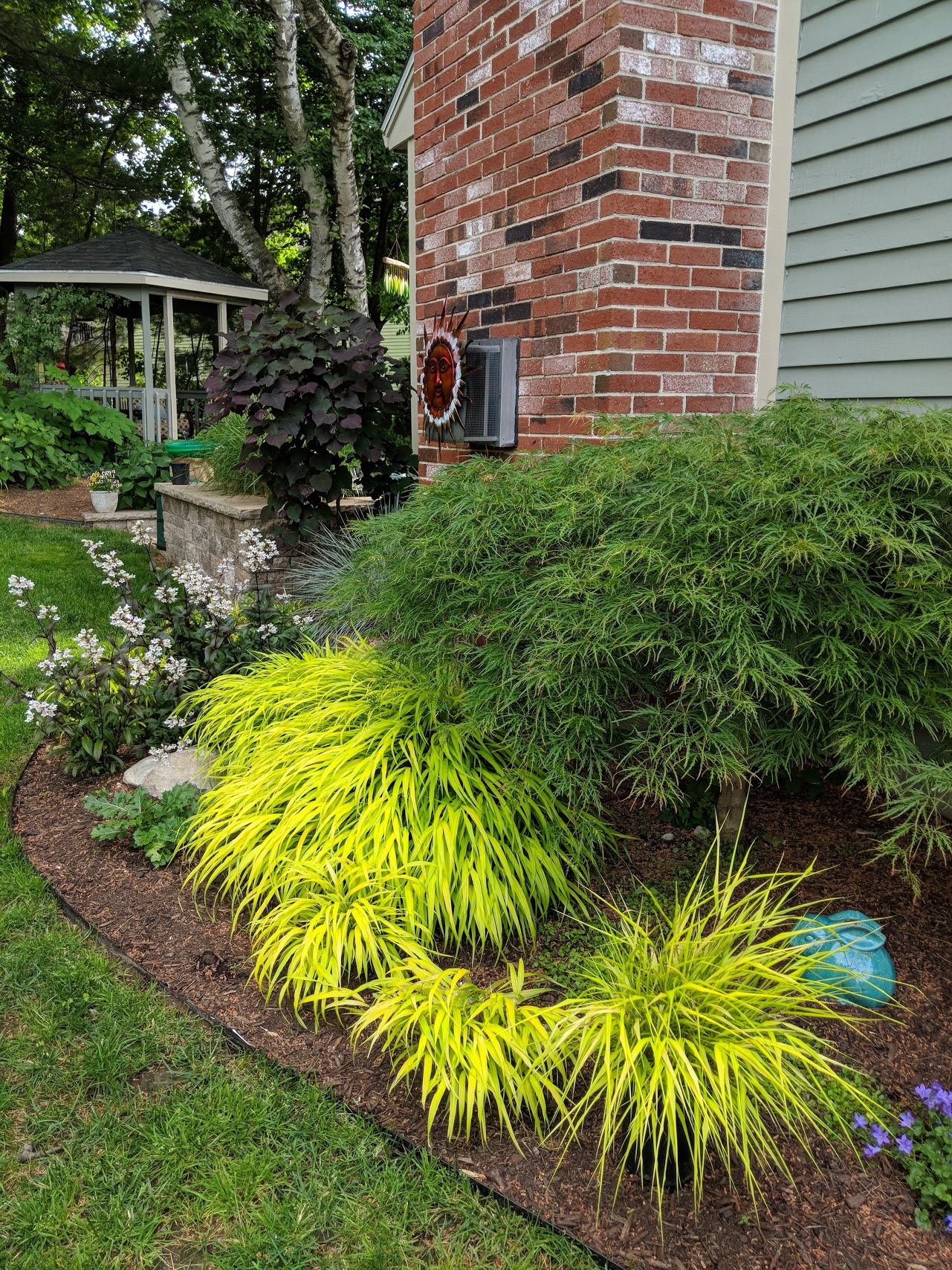Eastern Exposure (full sun to part shade)
Of all my gardens, the east beds illustrate what can be achieved through careful succession planting. From May until November change is a constant theme, offering beauty and essential wildlife habitat through the seasons.
What began as a sunny exposure bed, has evolved to a part-shade garden. Forty foot tall white pines, sugar maples and mature paper birch line the back of the property line. This tight space results in dozens of micro-climates as neighboring homes and trees cast long shadows and filter the afternoon sunlight. This means every year I need to adapt the plantings to the diminishing sun.
After years of tweaking and testing different sun-loving plants, this bed underwent a significant overhaul in May, 2018. Both beds along the East facing side of the house and garage were expanded to accommodate more plants and to give existing plants more room to stretch out. Drip-irrigation was professionally installed. Beds were again expanded in November, 2022 to accommodate a native Franklinia tree and more native perennials.
Before (photos from 2017): This bed has potential, but is constrained.
April, 2018 Drip Irrigation Installation:
In anticipation of bed expansion in early May, irrigation tubing was professionally installed in all of the foundation beds by Smart Water Irrigation. Tubes are durable, weather-proof and have evenly spaced "emitter" holes that deliver water slowly. Our existing Hunter lawn irrigation system had plenty of additional “zones” that were available for the new garden irrigation. Each zone has it’s own day and time pre-programmed based upon its unique water needs. Since installation, our utility bill has dropped meaningfully, due to the more efficient use of water and less evaporation. Plants are happier, too, as drip irrigation keeps foliage dry and less prone to disease. We can even extend the tubing ourselves to accommodate new plants, if necessary.
May, 2018 Bed Expansion (front half):
With efficient drip irrigation now installed, we decided to make this bed even more interesting. With the help of the Parker Garden Design crew, a new garden footprint was cut, turf was removed, and permanent aluminum edging installed. Rich compost was added to condition existing soil, improving the structure and adding beneficial nutrients. The new footprint is intentionally curvy in order to provide "reach in" access to the planting beds. Additional drip tubing was installed for even coverage of the entire garden bed.
May, 2018 bed expansion (back half):
The East garden is divided into two sections. The back half receives only about two hours of direct morning sun, followed by dappled shade, then full shade after 1:00 pm. I have been tinkering with this bed and swapping out plants as the neighbor's cherry tree grows ever taller, casting longer shadows and blocking the morning light. The Japanese Maple and Hakonechloa 'All Gold' are part-shade superstars and deserving of better companion plants.
The Cryptomeria Japonica that didn't survive its first NH winter was replaced with a young Eastern Redbud 'Ruby Falls' - something I've had my eye on for a long time. 'Ruby Falls' can also handle the shade as can the Hakonechloa 'Aureola' forest grass. Campanula 'Pink Octopus' is a vigorous, shade tolerant ground cover. Penstemon 'Husker Red Improved' was selected to complement the purple foliage of 'Ruby Falls'.
Photos in this gallery depict plant growth and the purple and gold color progression from late May install until early August.
May, 2018 ‘front half’ receives new plants:
This garden is the first to receive morning light and full sun until 1:00 or 2:00 p.m. The curvy new bed expansion offered me the opportunity to plant more of my spring lust plants, Penstemon and Amsonia 'Hubrichtii'. It also offered the chance to experiment with some new plants like Japanese Blood Grass and Clematis 'Rooguchi', strategically located to shield the late summer decline of the bee balm. (Blood grass was replaced a year later with more Penstemon to continue the gold and purple foliage theme.)
Mid-July and the penstemon and trollius have given way to agastache, monarda and verbena bonariensis. Joe Pye Weed anchors this bed against the garage wall and containers extend the bed around the corner to the driveway. Agastache 'Blue Fortune' is a hub of pollinator activity from sun up to sun down. By August, the tiny purple blooms of see-through plant Verbena Bonariensis hovers among and above other tightly planted perennials. The resulting effect is magical, especially in late afternoon sun. The next wave will come in September and October when two varieties of Goldenrod burst into bloom and the Amsonia 'Hubrichtii' foliage turns reddish-orange.
November 2022: another expansion begins
In my ongoing Crusade Against Turf, and desire for even more native plants, I again hired Parker Garden Design to make the east beds even deeper and curvier. The gorgeous weeping Japanese maple had finally succumbed to the damage it sustained many years earlier in a heavy snowstorm and had to be removed. While this was sad for me, I quickly realized that it presented an opportunity to plant an exciting native tree that I discovered while on a recent shopping trip at my wholesale nursery, Millican Nurseries, in Chichester, NH. With great excitement a multi-trunked Franklinia alatamaha was delivered and planted by the Parker Garden crew. The photos below show the remains of stunning fall foliage and a few white with egg yolk center blooms. The new home is sheltered from strong winds and will receive sufficient consistent moisture from the drip irrigation system. Franklinia’s are a bit finicky, so wish me luck in keeping this beauty alive and thriving!
Day Two: turf removal and edging installation
Professional installation of aluminum edging is a bit pricey, but worth it for years of carefree separation of planting beds and turf. This expansion will help ease out crowded plants and create new pockets for more sun loving native perennials and bulbs.








































